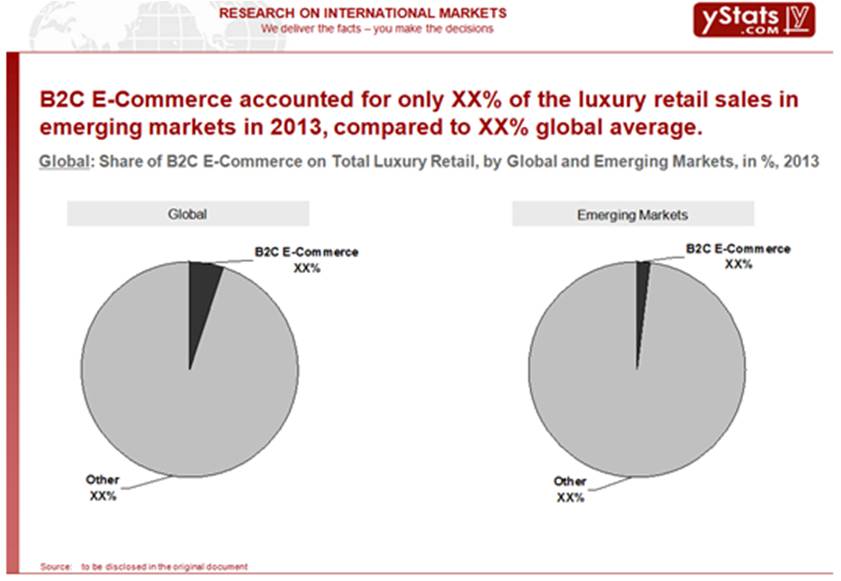The latest publication of Hamburg-based business intelligence organization yStats.com “Global Luxury B2C E-Commerce Snapshot 2014” reveals that even while the global B2C E-Commerce market was booming, few luxury brands were quick to embrace this sales channel. As a result, growing luxury E-Commerce revenues have gone to those companies filling in the gap: online and multi-channel retailers and flash sales sites. However, this status is gradually changing as the leading luxury brands increasingly establish their own E-commerce presence.
Worldwide, more than 10% of luxury consumers make their high-end purchases online, generating a high one-digit figure in EUR billion of luxury B2C E-Commerce sales. Sales are growing rapidly, as more luxury shoppers and luxury brands embrace the benefits of online retail. By 2019, the share of B2C E-Commerce on total luxury sales worldwide could grow by over a half.
The impact of B2C E-Commerce on the luxury market is still felt mostly in advanced economies, where the share of online retail on luxury market reaches double-digit figures in some countries, such as Germany and the UK. However, emerging markets such as Brazil, China, India and Russia, are forecasted to bring the largest share of growth. Consumers in these countries are already researching luxury products before making a purchase over the Internet more than the consumers in mature markets.
Moreover, selected emerging markets seem to be among the leaders in terms of luxury shoppers embracing mobile and social commerce. By share of luxury shoppers making purchases of high-end goods via smartphones and tablets, Brazil is even ahead of such mobile leaders as South Korea and the USA. As for social media engagement, over half of luxury consumers in China and Brazil follow their favorite luxury brands on social networks, and in China, social media is one of the most important channels for information about new luxury products.
Luxury brands are yet to tap the potential of online markets in some emerging countries. For example, in 2013 only a tiny percent of top luxury brands mentioned Middle East as their market on their website or translated the site to a language of the region. Even a smaller share of them offered shipping to this region, despite the known high demand for high-end goods in the Middle East. Similarly, only one in six top luxury brand websites invested into advanced translation of the online content into Russian and a similar small share offered international shipping to Russia, with the majority thus disregarding the potential of the booming cross-border B2C E-Commerce sales there.
Major Luxury Players Online
Overall, not even the largest international luxury companies have fully exploited the B2C E-Commerce potential. The two global leaders, LVMH and Richemont have direct E-Commerce operations only for some of their brands and offer shipping to a limited number of countries. Some other major brand players, such as Estee Lauder and Luxottica Group report growing revenues in the online segment and are gradually expanding their E-Commerce channel.
Meanwhile, the major online pure-play and multi-channel luxury specialists have been rapidly increasing their B2C E-Commerce revenues in recent years. Online luxury retailer YOOX Group which operates multi-brand and powers mono-brand shops of many luxury companies, saw a compound annual growth rate in revenues of over 30% between 2009 and 2013. Another pure-play, multi-brand luxury retailer Net-a-Porter, a subsidiary of Richemont, has seen growth of over 50% over the same period. Another sign of success of online retail is that luxury multi-channel retailer Neiman Marcus breached the 1 billion dollar mark in online sales in 2013.
In addition to the growing web presence of the luxury brand houses and online retailers, another group of players with increasing importance is the private luxury shopping clubs that offer luxury goods online at discounted prices through flash sales accessible to their members only. Worldwide, there are many examples of such companies, such as Beyond the Rack and Editor’s Closet in North America, Privalia in Latin America, Vente Privee and Amazon Buy Vip in Europe, Reebonz and Glamour Sales in Asia-Pacific and MarkaVIP and Runway [Sale] in the Middle East and Africa.




